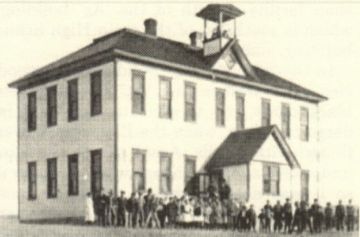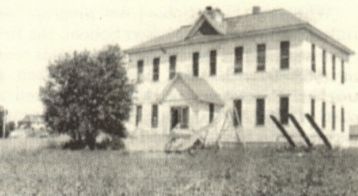HOOKER COUNTY, MULLEN ELEMENTARY SCHOOL
by Claudia Tompkins
Entry T24 from the History of Hooker County Nebraska
with permission of the Hooker County Historical Society

Mullen Elementary and High School about 1908

Mullen Elementary mid 1920's Improved front
steps and playground

New Elementary school built in 1938-39

Mullen Elementary, remodeled and new addition
about 1972
Plans for a school house in the town of
Mullen was laid in 1902, which was to be their
first school building but because of bad
weather, it had to be postponed till 1903 in
the spring. This school was located on the
northwest corner, a block north of the present
Episcopal church. It was built as a school, but
it served also as the first Methodist church
and was also the center of the social activities
of Mullen, such as box socials, literaries,
meetings, etc. A newspaper copy of the
picture of the school and pupils, taken by
W.E. Bowers at this period of time, is in the
Historical Society's files. This school was
short lived however, as it burned in April of
1904. Another two story building was soon
erected about 1907 as some postcards in the
files indicate. The building had two class-
rooms on the ground floor and two on the
second floor as well as a principal's office at
the end of the hall. The second floor was used
for high school students till a high school was
built in 1917.
The old frame Elementary School was in
use from about 1907 through to 1938, when
it was condemned for unsafe use. It was
moved to the back of the lot and a new
$36,000 brick building took its place in 1939.
This building had 5 classrooms, office and a
basement with a stage at the east end to be
used for school programs and activities. The
other basement space was used for recreation
for the pupils on stormy days and also the
space to set up folding chairs for programs
and for the public school meetings held
annually. James R. Cook was the Principal
when it was built. Gaynor Runquist was the
principal the fall of 1939. The old frame
building was reconstructed for a new high
school Vocational-Agriculture building.
This new building underwent another
change within its walls in the late '40's
because of the enrollment increase. There
had been two grades in each room up to this
point. Folding doors were added to one large
room to accommodate two single class rooms.
The last two grades, 3rd and 4th were moved
to the basement because 41 pupils over-
crowded their room upstairs. They had
plenty of space in their new room and had a
stage to use for their original plays to perform
for the other grades. A ping-pong table to use
for crafts in making gifts for parents or
general art work. Claudia Tompkins was the
teacher that year and Mrs. Wadlow was hired
as a remedial teacher the 2nd semester. Then
in a few years more Mr. Barnebey had to give
up his work shop in the west end so two more
class rooms could be made in the basement
and the stage was removed for a kitchen and
the remainder space for tables for a lunch
program.
In October of 1971, a vote for a bond to be
issued for building an addition to the 1939
brick building, which did pass. The new
addition on the ground floor was built
adjoining the south side of the east portion
of the original building. This large room was
designed to accommodate both elementary
and high school students for the lunch
program. It was also to be used for a music
classroom, and also be available for recrea-
tional activities, spelling bees and a place
where the public could hold large community
meetings. The kitchen was remodeled, the
old lunch area was to be used as an Art room
and the other two class rooms were made into
one, and one small sound proof room for
speech therapy. Above on the 2nd floor of this
new addition was a Kindergarten and a first
grade room. A library room replaced the old
folding doors and 7th and 8th area. A small
room at the east end, south was designed for
a remedial class room.
The elementary school has made much
progress from the original 1903 school. All of
the rural students are bussed to this school
so the Hooker County rural schools have all
vanished. Wouldn't the early pioneers be
proud!



